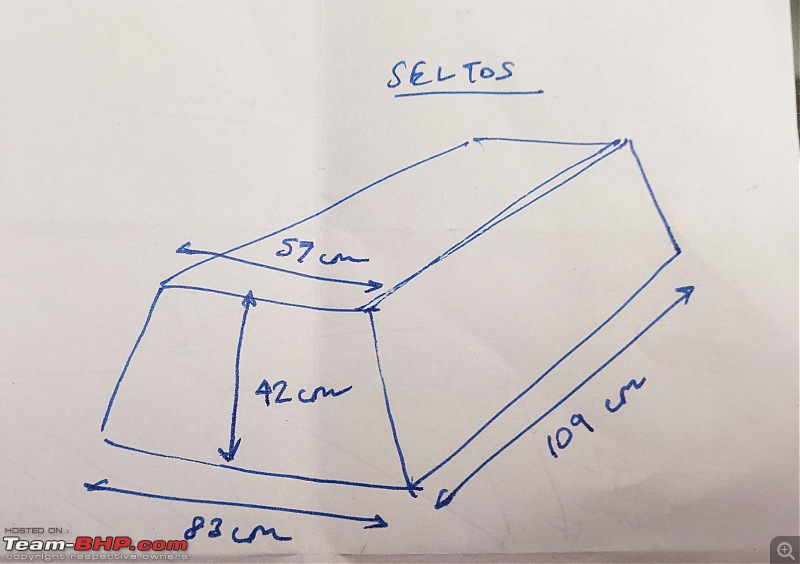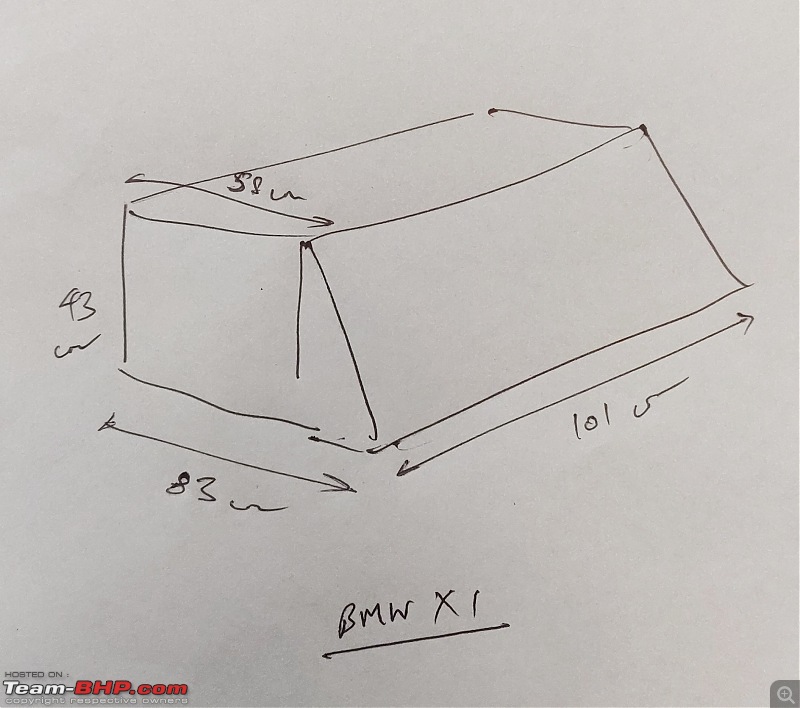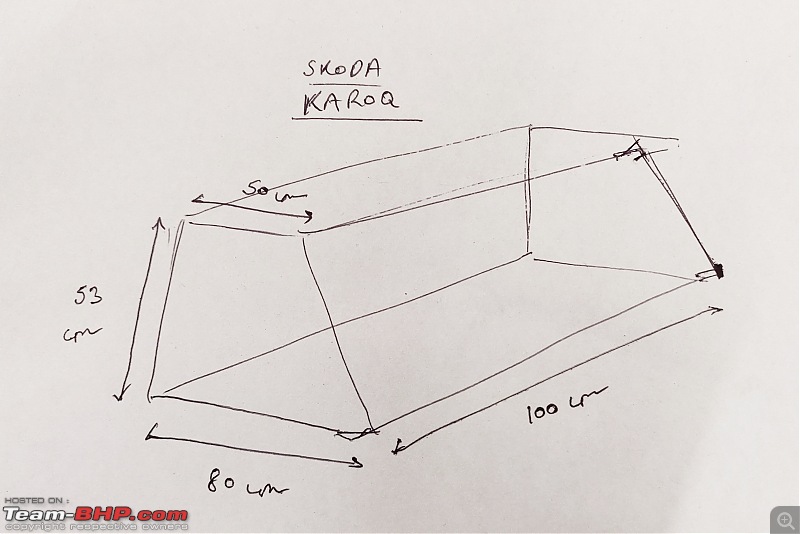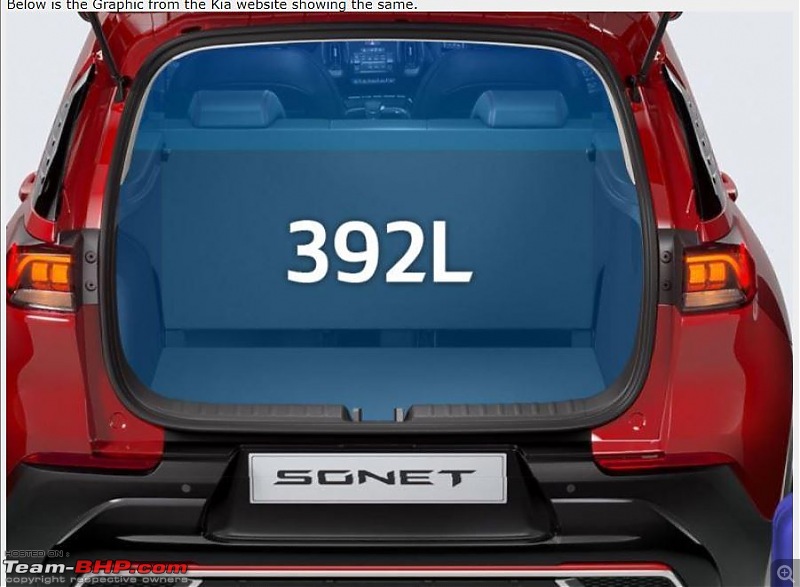Team-BHP
(
https://www.team-bhp.com/forum/)
Quote:
Originally Posted by Behemoth
(Post 4526004)
However the boot space of the Compass ( actual 320 L against 400+ claimed by the Company) is very less compared to the Laura which has close to 480L (actual). The Harrier should have a 400L+ actual bootspace (spare is below the car). The Kicks also has a full 400L bootspace as their spare is also below. I have measured the Captur bootspace which is close to 390+ L and much bigger than the Compass bootspace in reality
|
Maybe slightly OT, but thought I'd chip on the luggage calculations, as I had researched this while looking through the Endeavour's boot space numbers.
A volumetric integration of the actual boot dimensions would be of less practical value unless we want to use it as a fuel tank/water reservoir because 'real shaped' luggage and door handles/hinges and curvature etc severely deplete the number.
The VDA (German) system uses standard 1000cc wood blocks, of 20cmx10cmx5cm and checks how many of these 'liter' blocks is the manufacturer able to stack practically within the boot like Jenga and this is declared as X litres of boot space. European, Japanese, Korean marques like Honda, Toyota, Kia, Hyundai, Audi, BMW all use this unit. This is more realistic and conservative.
Because the Yanks
have to do everything differently, the SAE (US) uses a different system using 'standard' replica of usual luggage items, or use smaller blocks and stack it cleverly to arrive at the total luggage volume as X liters. This SAE figure generally conveys a large liter figure than VDA. Jeep, Dodge etc. use this method.
In your case, the Skoda and Captur being European origin, might declare the more conservative VDA number compared to the Jeep's SAE claim and hence closer to the measured 'reality'.
I would consider these numbers as ball park only and actually try to fit the largest item I intend to carry and check for myself if its a real deal breaker.
For e.g., a hatch/sedan I would use daily, I would try to check if the child stroller can fit comfortably, or if its the SUV, I would see if I can snuck in a mountain bike, with the seats down. If its the V cross, I would check if it can lash down my Himalayan:D
P.S: I
presume Tata and Mahindra use VDA, but will have to check.
Quote:
Originally Posted by vigneshkumar31
(Post 4526192)
Maybe slightly OT, but thought I'd chip on the luggage calculations, as I had researched this while looking through the Endeavour's boot space numbers.
|
Age old problem! Amongst things which have been used - table tennis balls, (and if you are a luxury car manufacturer) the number of golf bags one can carry!
I personally check with (airline) cabin luggage. Ridiculous if a passenger has to sit with cabin luggage on ones lap!
Regards
Sutripta
Quote:
Originally Posted by vigneshkumar31
(Post 4526985)
Maybe slightly OT, but thought I'd chip on the luggage calculations, as I had researched this while looking through the Endeavour's boot space numbers.
|
Many thanks for sharing, Vignesh! Am copying your post from the Harrier thread to this one too as anyone looking for info on the topic will find your post incredibly helpful :thumbs up.
Recently I went to see the Kia Seltos and took the actual boot measurements as below.

As per the Boot measurements, the actual boot space is :
(109 cm x 42cm x (57+83)/2 )/1000 = 310L and if you include the small niche on the left, it is around 10L and the total comes to 320L. This is with the rear seat in the upright position (rear seat is adjustable in recline in two steps). If the seat is reclined to the relaxed position the boot space will be even lesser by 30-40L.
This is the actual measured boot space below the parcel shelf and above the spare tyre cover. The claimed boot space is 430L - again another example of manufacturer overstating the boot space.
Today I got the chance to measure the actual boot space of the Hyundai Venue. This one was a pleasant surprise and the measured usable boot space of the venue comes to almost 340L (against the claimed 350L by the company).
The Venue actually has a bigger boot than the Seltos!

I thought this was a good experiment and tried to measure the boot size of Ignis using this approach and here are the results:
 Ignis Boot Dimensions
Ignis Boot Dimensions
Applying the same formula:
(114 cm x 50 cm x (60 cm + 38 cm) / 2) / 1000 =
279.3 L
The company rated boot size is
260 L. So, I think the
279 did not account for the wheel arch taking up some space of the boot but overall I think the boot size has been specified correctly in case of Ignis.
Measured the actual boot dimensions of another car today of which I did a test drive. The Bmw x1
The actual boot space as calculated by me based on boot dimensions is only 306 L
((58+83)/2 x 43 x 101) / 1000 = 306 L
Another example of overstated boot space by a manufacturer and actual boot space being much less than claimed!
Can something like this not be treated as misrepresentation of facts ?

So yesterday I went to see the Karoq and as always, I took actual measurements of the boot space to find out the real boot capacity. The measurements are as below:

The actual boot capacity below the parcel shelf comes out as
((50+80)/2 x 53 x 100 )/1000= 344.5 L. There are two niches on the sides of around 15 L each so total comes to around 375 L , which is drastically far from the claimed 520 L of the Karoq!
Very misleading numbers - Skoda sells the car in Europe without the spare wheel and is sharing the same numbers as boot space in India? Why can't manufacturers report the boot space properly. For the minimal boot space the Karoq is off my list now.
Two cars which actually have much bigger boot space than this and are reporting the boot size correctly are the Harrier and Nissan Kicks - both have a full 400L boot space area which is fully available and does not include the spare wheel.
Seriously these Csuv manufacturers need to take a lesson from Renault triber on Space management! Triber has a 620L boot in 5 seat mode in a car less than 4m length!
Quote:
Originally Posted by Behemoth
(Post 4819030)
Seriously these Csuv manufacturers need to take a lesson from Renault triber on Space management! Triber has a 620L boot in 5 seat mode in a car less than 4m length!
|
Good point. But then the Triber doesn't get SUV looks. It compromises on SUV looks to have a short bonnet and a large passenger compartment.
Length of the bonnet is a big factor in whether the car will be categorized as a van, hatchback or CSUV. Imagine a Karoq or Harrier with a short bonnet like Triber and the bragging rights of being an SUV goes out.
Copying the image from another thread here.
How do we measure boot space in a SUV?
The space BELOW Parcel Tray qualifies as boot space or all the space behind second row from roof to floor qualifies as a boot?

Quote:
Originally Posted by DriveOnceMore
(Post 4869559)
Copying the image from another thread here.
How do we measure boot space in a SUV?
The space BELOW Parcel Tray qualifies as boot space or all the space behind second row from roof to floor qualifies as a boot? Attachment 2045733
|
Well as per my logic, it should only be the usable space below the parcel shelf which should qualify as boot space. The space till the headliner is not safe for usage for luggage as there is a high risk of injury in case of accident and it also blocks the view out of the rear windshield - which is illegal as per law. In case of sedans the whole boot space is usable, but incase of SUVs I have found so many manufacturers using different standards and quoting inflated boot space , which is not even usable - which is why I started this thread - so people can get an actual idea of the real boot space of a car.
The case in point of the Sonet, people will soon find out that the real usable boot space of the Sonet below the parcel shelf is more than that of the Seltos - and it will be able to fit two additional medium size suitcases (40L) more than the Seltos.
Quote:
Originally Posted by Behemoth
(Post 4869572)
The case in point of the Sonet, people will soon find out that the real usable boot space of the Sonet below the parcel shelf is more than that of the Seltos - and it will be able to fit two additional medium size suitcases (40L) more than the Seltos.
|
Did you mean the other way?
I am confused after reading this.
Quote:
Originally Posted by DriveOnceMore
(Post 4869579)
Did you mean the other way?
I am confused after reading this.
|
Nope I meant it exactly like this - the boot space of the Venue too is more than the Seltos (below parcel shelf) - see the measurements shared a few posts back by me. The same will be the case for the Sonet too as it is built on the Venue platform. The key difference lies in the position of the boot floor which is too high on the Seltos and hence does not get enough height in the boot.
So today I went to see the Kia Sonet (My pics and views are shared on the Kia Sonet thread).
I also did the boot space measurement as per my method, for the area below the parcel shelf. The Boot measurements are as below:

As per these measurements, the Boot Volume (Below parcel Shelf) is :
(((70+40)/2) X 60 x 110) / 1000 = 363 L
Compared to the Company quoted 392 L (which is till the roof lining), this is quite reasonable.
This is very good usable boot volume and even better than the Kia Seltos (which had 320L of usable space below parcel shelf)
So in reality, you will be able to fit more luggage and stuff in the Sonet boot (below parcel shelf) than the Kia Seltos. The difference is 40L , so a medium size luggage bag extra is what I estimate.
| All times are GMT +5.5. The time now is 05:36. | |








